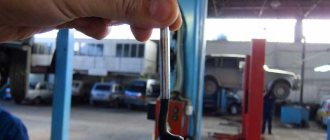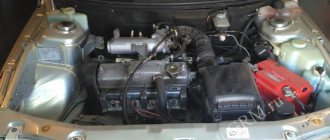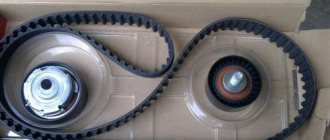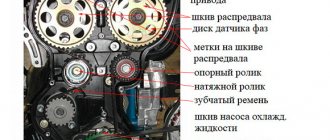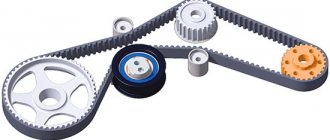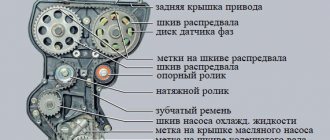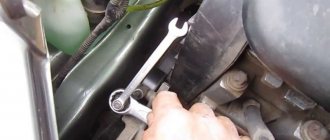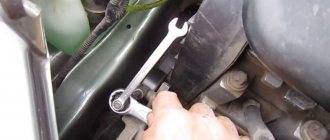Yesterday one of our regular customers came to us with a recently purchased second-generation Kalina to replace the timing belt, roller and pump, plus all the fluids, but more on that in another article. The frequency of belt replacement according to the regulations is 75 thousand kilometers or 4 years of operation, but as practice has shown, the optimal replacement interval is 60 thousand kilometers. This car has driven 80,000 miles, let's see what condition the strap is in.
Important! Let’s make a reservation right away that when the timing belt drive on this car breaks, all the valves bend. It is recommended to check the condition of the belt every 15,000 kilometers.
Necessary tools and accessories
To work, we will need a set of keys and sockets, as well as a 5-point hex and a key for the tension roller. The entire procedure takes approximately one and a half hours.
The Kalina engine is very similar to the eighth.
Why change?
The manufacturer has established a periodic scheduled period for belt replacement, expressed in mileage. So the owner should tend to the specified procedure every 50 thousand km. It is possible earlier if the condition of the specified consumable requires such action.
Important! Taking into account the quality aspects of the parts in the gas distribution mechanism, which includes the belt, it is recommended to reduce replacement to an interval of 30 thousand km.
The belt drive in Lada Kalina needs regular inspection. Visual inspection should be performed at least once a month. To do this, you will need to remove the protective cover. If the previously mentioned signs of wear appear on the surface of the belt, then such an element of the system should be replaced immediately, which will avoid a sudden break.
An excessively worn timing belt causes the cooling system water pump to malfunction. A break on some engine modifications leads to bending of the valves on the piston bottoms. In some cases, loose strands of belt cords can become wrapped around the generator set shaft, causing it to malfunction.
Note that on older modifications of engines with 8 valves, bending of the valves is not observed when the belt breaks. Impact does not occur due to special technological recesses on the piston heads. New 8-valve units and modifications with 16-valve heads cannot boast of such a useful protective option.
In the first case, when the belt drive breaks, the 8-valve motor stalls. After installing a new product, you can continue using it. The second option involves repairing the Lada Kalina engine.
Step-by-step instruction
- Loosen the locknut of the generator belt tensioning mechanism. Using a 10-mm socket, unscrew the tensioning mechanism pin and remove the drive belt, checking for wear, cracks and traces of oil. We check the tension roller when rotating; it should not make any extraneous noise. To replace the generator belt on Kalina, you will have to remove the engine mount, first dismantling the protection and jacking up the power unit.
- Remove the upper protective cover of the timing belt by unscrewing the four bolts (hexagon 5).
Set the top dead center
- We turn the crankshaft by the pulley mounting bolt clockwise until the mark on the camshaft pulley and the timing belt guard coincide.
Be sure to rotate the crankshaft clockwise, otherwise increased force will be applied to the timing parts.
Mark on the camshaft.
- We unscrew the bolt of the auxiliary drive pulley (in common parlance - the crankshaft). We block the wheels with stops, tighten the handbrake, engage fifth gear and, with a slight movement of the wrench and a one and a half meter pipe extension, unscrew this bolt. Repair books also advise opening the plug on the clutch housing and aligning the marks on the flywheel, but this is an absolutely useless procedure. Firstly, the flywheel could simply be misplaced according to the marks, for example when replacing the crankshaft oil seal, and secondly, in order to provide access to this mark, it is necessary to remove the air filter housing with the corrugation. And why do we need these extra operations?
Important! Never remove the crankshaft bolt with the starter.
- Next, use the same 5mm hexagon to unscrew the bolts securing the lower timing belt cover and remove it.
- Remove the protective washer.
- The marks on the crankshaft timing belt should be aligned with the oil pump housing.
Crankshaft mark.
- Praise be to the designers of AvtoVAZ, finally rollers with a tension indicator appeared on the Lada Kalina 2 engines, now you don’t need to pull it on by eye and check the tension by twisting the belt, not even thirty years have passed since the invention of such a design. We unscrew the tension roller bolt and dismantle the latter; we also remove the old timing belt. The photo shows that the belt has stretched out because the tension marks have diverged; when checking the condition of the timing belt, if you see this, you will just need to tighten it.
Replacing the pump
- To replace the pump, we need to remove the camshaft pulley, and also unscrew a few bolts of the inner casing and remove it. If signs of wear are found on the camshaft pulley, it is better to replace it.
- Three bolts out and the pump replaced (hexagon 5). The green arrow indicates the hole for the tension roller bolt.
Pump mount.
- Having replaced the water pump, we proceed to the next stage.
Engine VAZ 21114
This power unit is an injection gasoline engine with a displacement of 1600 cm3. This is a modernized version of the VAZ 2111 engine. The cylinder block is cast from cast iron, four cylinders are located in one row. The valve train of this engine has eight valves. The injector made it possible to significantly improve the car’s dynamics and fuel economy. Its parameters comply with Euro-2 standards.
The valve mechanism drive uses a toothed belt, which somewhat reduced the cost of the power unit, but requires high-quality, timely maintenance of the timing drive. The design of the piston head provides recesses that completely eliminate the possibility of damage to the valve mechanism if the timing belt is damaged or installed incorrectly. Manufacturers guarantee a motor life of 150 thousand km; in practice, it can be more than 250 thousand km.
Installing a new timing belt
- We put the casing and camshaft pulley in place.
- Then you should check the coincidence of all the marks, as discussed above.
- We install the tension roller, but do not tighten the bolt.
- We put on a new belt, observing the direction of rotation, first on the crankshaft pulley, camshaft pulley, tension roller and pump, the latter can be swapped.
We make sure that the descending branch of the belt is tensioned.
- We tighten the timing belt. Use a special key to turn the roller counterclockwise, as indicated on its body...
Tension direction.
- ...until the marks on it coincide and tighten the bolt.
Correct tension.
- We turn the crankshaft two turns to make sure that the pistons do not meet the valves and again check that the marks match and the belt tension.
The timing belt is installed.
- We install all the parts in the reverse order of removal, fill in antifreeze and start it.
It couldn’t be simpler; this procedure can be done with your own hands in the field, without going to a car service. In general, I really like Kalina, easy to repair, cheap spare parts, easy to use, what else do you need to be happy?
Types of faults
In practice, there are three types of timing belt drive faults:
- loss of integrity;
- break;
- incorrect degree of tension.
The first option is dangerous due to belt delamination. Hanging threads will indicate this phenomenon. Sheared teeth are also quite common. Such damage is caused by incorrect adjustment of some components of the mechanism, including:
- gears on camshafts;
- crankshaft pulley;
- tension roller;
- cooling circuit pump;
The belt is tensioned using a special roller with an eccentric shaft. By rotating the roller, you can increase or decrease the tension level. The main thing here is to avoid excessive tension, which will adversely affect the condition and service life of the belt. Also, you should not leave a weakened belt drive, which threatens the teeth on the shaft gears jumping. In both cases, the timing belt in the Lada Kalina will stop functioning normally.
A belt break occurs if the owner of a Lada Kalina does not take timely measures to replace this important consumable component. When such a situation occurs, further operation of the 8-valve motor is impossible. The car should be transported by tow truck to the repair site. And the timing belt will need to be replaced.
see also
Comments 28
www.drive2.ru/l/8981345/?page=0#a163962325 On the K-1 I replaced the belt, the roller and the pump, mileage 52,000, and because of the pump I changed it, it started to crunch and “pee”, although the belt and roller are still there something on the shelf.
I have already replaced the belt with the roller with 59000, I will change the pump later
At 45 thousand they did both valve adjustment and inspection (they had to according to the maintenance regulations). After the warranty expires, I don’t go to the officials, because... not satisfied with the quality of their work, price and attitude towards the client. That's actually why I'm asking :)
Don’t forget that the imported belt is ten times better quality than the previous one. generations of this engine. The self-tensioning pulley is also sold complete with a belt and is also considered a very high-quality product. But the pump... In stores they sell either Lada-detail or Luzar. On board. I saw someone in magazines praising the DOLZ L121. I think it’s somewhat naive to just change everything, new parts can be worse than the original ones. It is necessary to carry out troubleshooting by removing the belt, checking it carefully for cracks, peeling, the pump for jamming, play, squeaks and tension similarly. And then you can bring a candle to church))))
I don’t understand...WHY is this belt better than BRT? Everyone says high-quality, high-quality, high-quality. What is its quality?
It is clear that taste and color are all relative, but by default, imported spare parts from more or less famous manufacturers are considered to be of higher quality than domestic ones, if only because they have a longer service life compared to ours. There are exceptions, of course.
Cost of the replacement event
The price of a timing belt in a retail chain varies between 400-600 rubles. a piece. When the tension roller needs to be replaced, then we safely add about 500-600 rubles to the indicated amount.
The cost of the replacement service reaches 800 rubles, and if the roller needs to be replaced, then the expected depletion of the owner’s wallet will be about 1000 rubles.
When purchasing, we recommend considering the original version of the belt produced by VAZ. If this option is not available, then you can take a closer look at an analog product offered by one of the well-known brands.
Next, we present samples of belts with catalog codes. Here you will find the original product and its worthy imported substitutes.
Reviews
And you can decide which timing belt for the Grant is right for you based on reviews from the owners of this car.
Oleg: after running into a Boshev counterfeit, I prefer products from a domestic manufacturer. This is the second time I have bought a BRT belt. It runs the required 75 thousand without any problems. I recently changed the tension roller. I installed the Vologda one, let's see how it performs
Vitaly: I prefer not to skimp on spare parts, so I only install from the German manufacturer Gates. You can feel calm with it even on a long trip.
Slava: the most reliable and proven option is the manufacturer Contitech. Although it is more expensive than Bosch, the quality is many times better. My friend (his Kalina) and I bought it at the same time. He took something cheaper, made in Russia. The salespeople talked me into talking about Contitech. I'm very pleased, because my friend threw his away a long time ago, and I still drive it. Although it looks like new, I’m thinking of changing it, it’s already done more than 130 thousand. I'll take the same one.
Parts from the VAZ catalog
Let’s immediately look at the list of VAZ components and special tools:
- Tensioner roller for internal combustion engine 11183 – 2108-1006120, nut for it – 00001-0021647-21;
- Timing belt (11183) – 2108-1006040-10;
- Automatic tension roller – 21116-1006226;
- Timing belt (11186/21116) – 21116-1006040;
- Key for automatic roller – 67.7812.9573-01;
- Key for roller VAZ-11183 – 67.7834.9525.
The tension roller of the "2108" family has two slots on one side. These slots should look “up”, that is, away from the engine.
Tensioner roller for motor 11183
The slots were made for special tools. It is designated by the numbers “67.7834.9525” (see list). And for automatic rollers, the key is designated differently - “67.7812.9573”. What it looks like is shown below.
The automatic roller can also be adjusted
It remains to list how the mounting bolts, washers, etc. are designated:
- Three bolts for the VAZ-11183 cover – 00001-0009024-11, washers – 00001-0026406-01;
- Timing drive cover (11183) – 21080-1006146-10;
- Bolts for VAZ-21116 covers – 2108-1003286-00, spring washers – 00001-0011977-73;
- Top cover – 21116-1006226-00, bottom cover – 21116-1006218-00.
We hope no questions arise here.

